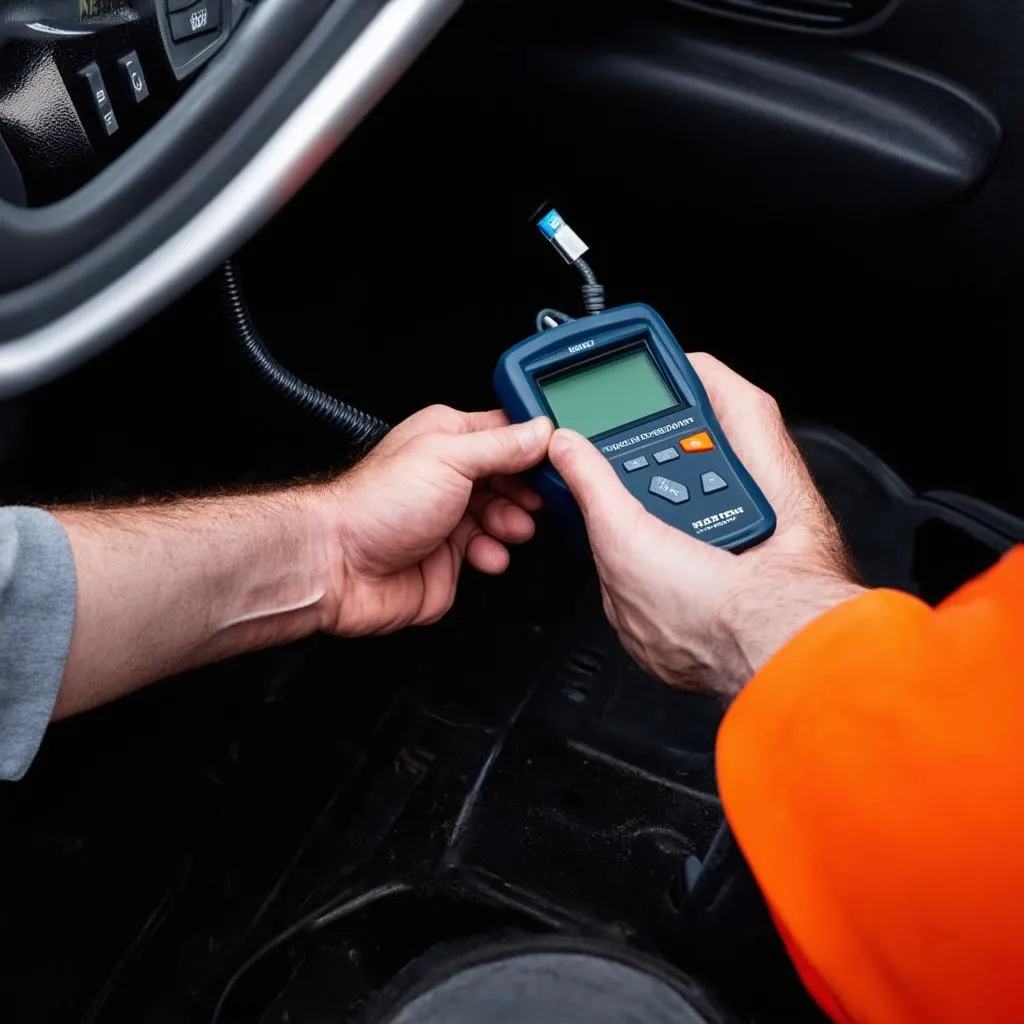“My check engine light just came on, and I’m freaking out!” Does this sound familiar? It happened to John last week. He was driving his trusty ’02 BMW when suddenly, the dreaded yellow light illuminated his dashboard. A quick trip to the auto parts store and a scan later, he was hit with “Obd Code P1133.” Lost and confused, John, like many car owners facing unfamiliar codes, felt a wave of panic.
Don’t worry; you’re not alone. This article delves deep into the world of OBD Code P1133, explaining what it means, its causes, and how to get your car back on the road.
Deciphering the Obd Code P1133 Enigma
Let’s break it down. OBD stands for On-Board Diagnostics, essentially your car’s way of communicating with you (or your mechanic). Code P1133 specifically applies to European cars and often indicates a problem with the oxygen (O2) sensor. Think of the O2 sensor as your car’s lung, measuring the oxygen content in the exhaust to ensure optimal fuel combustion.
What Does P1133 Mean?
In simpler terms, P1133 usually signifies that your car’s computer, the Engine Control Unit (ECU), has detected an issue with the heating circuit of the pre-cat O2 sensor (the one located before the catalytic converter). This heating element is crucial, especially during cold starts, as it helps the O2 sensor reach its operating temperature faster for accurate readings.
Why Should You Care About Obd Code P1133?
Ignoring this code can lead to:
- Decreased Fuel Economy: A malfunctioning O2 sensor can throw off the fuel-air mixture, leading to your engine burning more fuel than necessary.
- Poor Engine Performance: Expect sluggish acceleration, rough idling, or even stalling if your engine isn’t getting the right air-fuel balance.
- Failed Emissions Tests: A faulty O2 sensor can increase harmful emissions, causing your car to fail emissions tests.
Common Causes of P1133
Several culprits can trigger the P1133 code, including:
- Faulty O2 Sensor: The most common culprit is a worn-out or damaged O2 sensor.
- Wiring Issues: Damaged, corroded, or loose wiring connections to the O2 sensor can disrupt the heating circuit.
- Blown Fuse: A blown fuse in the O2 sensor’s circuit can cut off power to the heater.
- Faulty ECU: In rare cases, a malfunctioning ECU might be misinterpreting signals or failing to provide power to the sensor heater.
Troubleshooting and Fixing P1133
While consulting a qualified mechanic is recommended, here’s a simplified approach to tackling P1133:
-
Check the Codes: Start by scanning your car for other error codes alongside P1133. Sometimes, multiple codes can point to a single underlying issue.
-
Inspect the Wiring: Visually inspect the wiring harness leading to the pre-cat O2 sensor for any visible damage, loose connections, or corrosion.
-
Test the O2 Sensor Heater: Using a multimeter, test the resistance across the heater circuit of the O2 sensor. If the resistance is out of spec, replace the sensor.
-
Replace the O2 Sensor: If the O2 sensor is confirmed faulty, replace it with a new one from a reputable brand.
-
Check the Fuse: Locate and inspect the fuse related to the O2 sensor heater circuit. Replace it if blown.
-
Consult a Professional: If the problem persists, it’s best to seek professional help. A qualified mechanic can diagnose and address any complex electrical issues or potential ECU problems.
 Car Diagnostic Tool
Car Diagnostic Tool
The Spiritual Side of Car Troubles
While we’ve covered the technical aspects, some car owners find solace in exploring the less conventional side of car problems. In some cultures, a malfunctioning car, especially recurring issues, is seen as a sign of imbalance or blockage in one’s life. While this is purely anecdotal, it can be a fascinating perspective.
FAQs about Obd Code P1133
Q: Can I still drive my car with code P1133?
A: While you might be able to drive for a short period, it’s not recommended. Ignoring the issue can lead to further damage and costlier repairs down the line.
Q: How much does it cost to fix code P1133?
A: The cost can vary depending on the root cause and labor charges. Expect to pay between $100 to $400 for parts and labor.
Q: Can a bad O2 sensor damage my catalytic converter?
A: Yes, a malfunctioning O2 sensor can eventually lead to catalytic converter failure, which is a much more expensive repair.
Related OBD Codes and Car Models
OBD code P1133 often appears alongside other codes, such as:
- P1130: O2 Sensor Circuit Malfunction (Bank 1, Sensor 1)
- P1131: Heater Circuit Open (Bank 1, Sensor 1)
- P1135: Heater Circuit Malfunction (Bank 1, Sensor 1)
This code is common in various European car brands, including:
- BMW
- Mercedes-Benz
- Audi
- Volkswagen
- Volvo
- Mini Cooper
For instance, if you own a Chevy and encounter the P1133 code, you can find more information in our article specifically tailored for Chevy vehicles: Chevy OBD Code P1133. Similarly, for those with a 2001 Camry experiencing code P1135, we have a detailed guide here: 2001 Camry OBD P1135.
 Car Repair
Car Repair
Need More Help? We’re Just a Message Away!
Dealing with car troubles can be stressful, but remember, you don’t have to face them alone. For expert advice, assistance with diagnostic tools, or any car repair needs, don’t hesitate to contact us on WhatsApp at +84767531508. Our team of experienced mechanics is available 24/7 to provide guidance and support.
Final Thoughts
Understanding your car’s language is empowering. While encountering OBD codes like P1133 might seem daunting, a little knowledge goes a long way. By addressing the issue promptly and seeking professional help when needed, you can keep your car running smoothly and safely.
Do you have any experiences with OBD code P1133 or other car repair stories you’d like to share? We’d love to hear from you in the comments below! Remember, sharing knowledge helps others facing similar challenges.